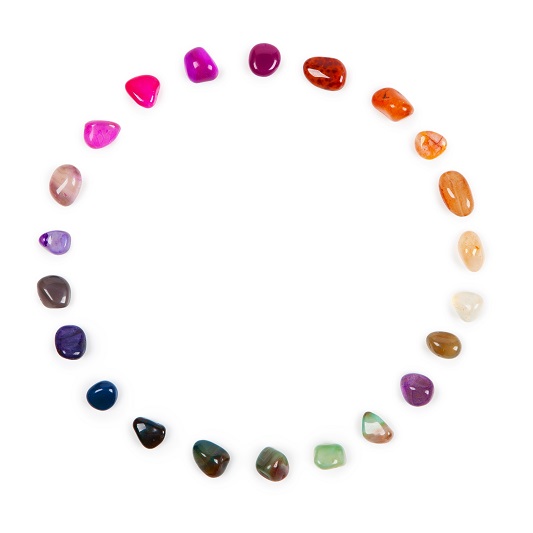Garnet, the gemstone of the week

Topaz: Gemstone of the Week
14th December 2017
Gemstone of the Week: Amethyst
5th January 2018Most commonly occurring with a deep red hue, Garnet is popular worldwide. Many people think of red Garnet as being the only colour, however, specimens can be found in almost every colour imaginable. The word ‘garnet’ originates from the Latin word ‘granatum’ – an adjective that means ‘dark-red’. A few others believe that the word derives from the word ‘pomegranate’, due to the colour and shape of the seeds of the fruit. The precious stone has been used for thousands of years. Most notably, Garnet was used by Egyptian pharaohs for both ceremonial and decorative purposes. In this article, we explore the lustrous gemstone in more detail.
How to Identify Garnet
Like many gemstones, Garnet can easily be confused with those showing a similar appearance. However, there are a number of ways that the stone can be distinguished. Unfortunately, there is no simple way for the untrained eye to identify the stone; for professionals, though, the process is usually quick and easy. It’s not uncommon for the gem to be confused with tourmaline and emerald; however, these two gemstones hold a different cubic crystal system to Garnet, so identification can take place this way. One of the most popular ways to identify Garnet is by its hardness. A fairly hard stone, the gem measures around 7 on the Mohs scale. For those with the right equipment, the easiest way to identify Garnet is with the use of neodymium magnets. Due to the high levels of iron and/or manganese in the stone, Gar-net is attracted to the magnets.
Different Colours and Types of Garnet
Garnet is best described as a gem group. The group itself holds over twenty varieties of the stone. How-ever, only six of these varieties are commonly used as gemstones. These are Almandite, Spessartite, Grossularite, Pyrope, Andradite and Uvarovite.
Of those six, Pyrope and Almandine are the most popular. Typically, Pyrope boasts great transparency and minimal flaws or inclusions. Because of this, the stone is often used within gemstone jewellery. While Almandine is widely available, it is often opaque and thus not fit for jewellery purposes. Occasionally, deep red forms of Almandine can be found. Due to their rarity, these specimens are incredibly sought after and carry with them a hefty price tag.
Spessartite varieties are usually orange to orange-red in colour. In recent years, this form of Garnet has increased in popularity. In the near future, we can expect to see more of these specimens on the gem-stone market. Grossular can appear in a range of different colours. Green specimens of this variety are often classed as green Tsavorite, while orange-brown types can be classed as Hessonite.
Andradite is seen as the most lustrous of all the types. In this category falls the rare Demantoid stone, the yellow Topazolite, and black variety of Melanite. Uvarovite is the rarest form of Garnet. Specimens of this type are rarely large enough to be faceted, making it the least popular for use within gemstone jewellery.
Other popular types of Garnet are the colour changing variety and specimens that display asterism. Col-our-changing stones appear a different colour when viewed in natural and artificial light. The most com-monly appearing colours are orange in natural light, changing to pink when placed under an artificial source. Specimens that display asterism appear to show four-rayed stars. This type of stone is extremely rare, especially specimens of fine-quality.
Where is Garnet Found?
Today, Garnet is mined from all over the world with different colours occurring in different locations. Blue Garnet is one of the most recently discovered colours. First mined in Madagascar in the 1990s, Blue Gar-net can now be found at various location worldwide.
Thousands of years ago, large deposits of Garnet were only found in Bohemia, Central Europe. While de-posits are less common today, Bohemian Garnet can still be mined from the Czech Republic. While red specimens from this location are most common, a variety of different colours can be found.
Healing Properties of Garnet
Various types of Garnet are popular within crystal healing. The precious stone is believed to utilise crea-tive energy, making it ideal for those in need of creative inspiration. It also grounds spirit forces within the body, helping one to live in harmony amongst others. Garnet is also a sensual stone. Representing the primordial fire, purification, and love, the stone is often gifted to show passion and intense feelings.
Garnet can be used within crystal healing to cleanse and re-energise the chakras. The stone is thought to purify, revitalise, and balance energy. Additionally, the gem is believed to encourage both love and devo-tion. Great for balancing the sex drive and ridding emotional disharmony, Garnet is often used within couples therapy. Activating and strengthening the survival instinct, it is thought to bring courage and hope to both individuals and their relationship.
Physically, Garnet is believed to stimulate the metabolism and regenerate the body. It also eases disor-ders of the spine, bone, cellular structure and composition. Garnet is thought to purify the heart, blood, and lungs, as well as increasing energy levels and boosting the immune system.
In Summary
Fine quality Garnet is popular worldwide. Today, the most common types can be found in various loca-tions all around the world. Loved for its perfect transparency and lustrous shine, many varieties of Garnet are used in designer jewellery. Whether you’re hoping to use the stone for its benefits within crystal healing or you’re looking for a beautiful new addition to your jewellery collection, purchase a good-quality piece of Garnet to reap the benefits.




